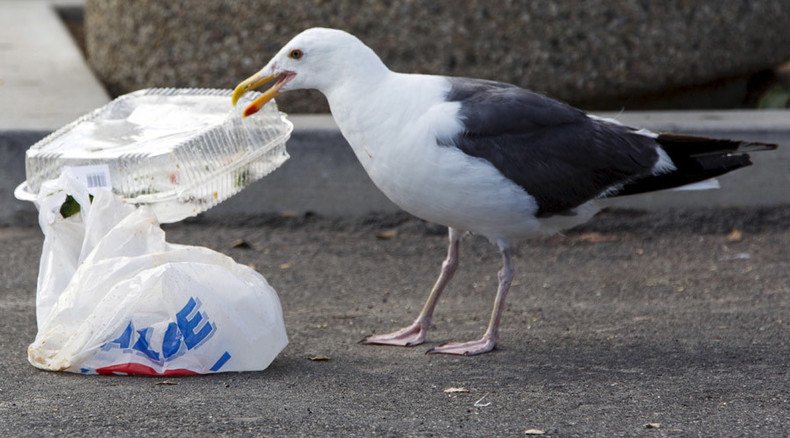4 million of plastic bits litter San Francisco Bay daily – study

The San Francisco Bay contains more concentrations of plastic litter than the Great Lakes and the Chesapeake Bay, a new study finds. "Microbeads" from cosmetic products are among the million plastic particles per square kilometer in the South Bay.
Nearly 4 million bits of non-biodegradable plastic flood the bay each day from eight of the area's large sewage treatment plants, according to the study done by the San Francisco Estuary Institute. More than half of this pollution consists of plastic fragments, including microbead pieces that come from cosmetic and personal care products. About a quarter of the material is synthetic fabric from clothing. Lesser concentrations of pollution include that of plastic bags or packaging and foam.
ICYMI Billions of pieces of tiny plastic litter found in San Francisco Bay http://t.co/zC01q7mF7b@PaulRogersSJMNpic.twitter.com/hxplMJRgoc
— Mercury News (@mercnews) September 22, 2015"We're concerned about these high levels. This was unexpected," said Rebecca Sutton, a senior scientist at the San Francisco Estuary Institute and lead researcher for the study, the first of its kind to document the extent of "microplastic" pollution in the San Francisco Bay.
READ MORE: 99% of seabird species to be affected by plastic ingestion by 2050 – report
The concentrations of plastic contaminants were collected by researchers using meshed nets in nine areas of the bay, from Oakland to San Jose. In South Bay, they found an average of a million plastic bits per square kilometer on the surface of the water or a few inches below. That concentration is nine times higher than levels of microplastics found in Lake Erie, the most polluted of the Great Lakes.
Around Oakland and San Francisco, researchers found 310,000 plastic pieces per square kilometer, double the levels in the Chesapeake Bay near the Patapsco River and three times the amount in Lake Erie.
Like that scene in "Brazil" with the scrap paper, but with plastic: San Francisco Bay is full of plastic microbeads http://t.co/0WDLIKVktN
— Mike Oriza—a fun guy (@brechett) September 23, 2015Nine small fish were also captured as researchers dragged nets through the bay, Sutton said. Each fish contained an average of six plastic pieces, indicating how the bay's pollution affects marine life and, in turn, humans who eat fish from the bay.
READ MORE: Sea shame: 155mn tons of plastic trash in world oceans by 2025, study finds
Fish and other wildlife are also absorbing pesticides and PCBs, a likely human carcinogen, from the bay's polluted water, according to past studies.
"San Francisco Bay is facing a legacy of polychlorinated biphenyls (PCBs) spread widely across the land surface of the watershed, mixed deep into the sediment of the Bay, and contaminating the Bay food web to a degree that poses health risks to humans and wildlife," according to a 2007 study.
San Francisco Estuary Institute researchers also tested treated wastewater from eight of the bay's top sewage treatment plants that discharge into the bay, including the Central Contra Costa Sanitary District, the East Bay Municipal Utility District, Palo Alto, and San Jose. The plants are not designed to catch microparticle plastics, and thus each plant contained a multitude of plastic bits that will eventually flow unfiltered into the bay.
Sewage treatment facilities in Oakland and San Jose discharged the most plastic given those areas' dense populations. Researchers noted that plastics also find a way to the bay via storm drains, creeks, and illegal dumping.
READ MORE: EU Parliament backs drastic cuts to irrepressible plastic bag use
"The micro-particles are of concern to us," said David Williams, executive director of Bay Area Clean Water Agencies, according to the San Jose Mercury News. "We've known for some time that there are things that our plants just don't remove."
Williams said adding filtering capabilities to the treatment plants would cost millions of dollars, and that an immediate solution should be to avoid buying so-called "microbead" cosmetics and other personal care products.
A bill was passed this month in California that bans plastic microbeads – defined as five millimeters or less in diameter – in cosmetic products by 2020. Plastic manufacturers and other industry groups failed to get an exemption from the bill, the toughest of its kind in the US. Gov. Jerry Brown has yet to say whether he will sign the legislation into law.
A separate study released last month found that 90 percent of all individual seabirds alive today have eaten plastic of some sort – an 85 percent increase since 1960 -- and that 99 percent of seabird species will be impacted in the coming decades.












